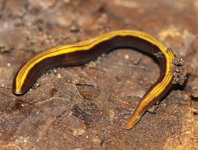Abstract
The Bengal monitor lizard or Common Indian monitor lizard (Varanus bengalensis Daudin, 1802) is classified as Least Concern under the IUCN and listed under the Schedule-I of the Indian Wildlife Protection Act 1972. Further, the trade of the species is prohibited as the species is listed in Appendix I of CITES. It is widely distributed over Western Asia, the Indian Subcontinent, and Southeast Asia (Koch et al. 2013). It is reported to occupy both terrestrial as well as freshwater habitats from desert areas to floodplains, scrubland to forests, in different types of terrains at elevations below 1500m (Auffenberg 1994; Papenfuss et al. 2010). Body size of individuals varies from 61 to 175 cm from the tip of the snout to the end of the tail (Auffenberg 1994; Losos and Greene, 1998). Adults are generally grey or greenish-grey in color, with a ventral pattern of grey to black crossbars from the chin to the tail. Adult individuals are less contrasting and have a less distinct pattern than younger individuals. The species shows a sexual dimorphism, with males being heavier (around 7.18 to 10 kg) than females which are about 40% smaller in size (Papenfuss et al. 2010).
References
Alabia, I.D., García Molinos, J., Saitoh, S.I., Hirawake, T., Hirata, T. & Mueter, F.J. (2018) Distribution shifts of marine taxa in the Pacific Arctic under contemporary climate changes. Diversity and Distributions, 24 (11), 1583–1597.
https://doi.org/10.1111/ddi.12788
Auffenberg, W. (1994) The Bengal Monitor. University Press of Florida, Gainesville, Fl, 560 pp.
Barry, J., Baxter, C., Sagarin, R. & Gilman, S. (1995) Climate related, long-term faunal changes in a Californian rocky intertidal community. Science, 267, 672–675.
https://doi.org/10.1126/science.267.5198.672
Bhattacharya, S. & Koch, A. (2018) Effects of Traditional Beliefs leading to Conservation of Water Monitor Lizards (Varanus salvator) and threatened Marshlands in West Bengal, India. Herpetological Conservation and Biology, 13 (2), 408–414.
Das, I. (1989) Indian monitor lizards: A review of human utilisation patterns. Hamadryad, 14 (1), 16–19.
Epstein, P.R., Diaz, H.F., Elias, S., Grabherr, G., Graham, N.E., Martens, W.J., MosIey-Thompson, E. & Susskind, J. (1998) Biological and physical signs of climate change: focus on mosquito-borne diseases. Bulletin of the American Meteorological Society, 79 (3), 409–418.
https://doi.org/10.1175/1520-0477(1998)079%3C0409:BAPSOC%3E2.0.CO;2
Grabherr, G., Gottfried, M. & Pauli, H. (1994) Climate effects on mountain plants. Nature, 369 (6480), 448.
https://doi.org/10.1038/369448a0
Jezkova, T., Jaeger, J.R., Oláh-Hemmings, V., Jones, K.B., Lara-Resendiz, R.A., Mulcahy, D.G. & Riddle, B.R. (2016) Range and niche shifts in response to past climate change in the desert horned lizard Phrynosoma platyrhinos. Ecography, 39 (5), 437–448.
https://doi.org/10.1111/ecog.01464
Koch, A., Ziegler, T., Boehme, W., Arida, E. & Auliya, M. (2013) Pressing problems: distribution, threats, and conservation status of the monitor lizards (Varanidae: Varanus spp.) of Southeast Asia and the Indo-Australian Archipelago. Herpetological Conservation and Biology, 8 (3), 1–62.
Losos, J.B. & Greene, H.W. (1998) Ecological and evolutionary implications of diet in monitor lizards. Biological Journal of’ thc Linnean Suciety, 35, 379–407.
https://doi.org/10.1111/j.1095-8312.1988.tb00477.x
McCain, C.M. (2005) Elevational gradients in diversity of small mammals. Ecology, 86 (2), 366–372.
https://doi.org/10.1890/03-3147
Papenfuss, T., Shafiei Bafti, S., Sharifi, M., Bennett, D. & Sweet, S.S. (2010) Varanus bengalensis. The IUCN Red List of Threatened Species, 2010, e.T164579A5909661. Available from: http://dx.doi.org/10.2305/IUCN.UK.20104.RLTS.T164579A5909661.en (accessed 12 July 2019)
Pernetta, A.P. (2009) Monitoring the trade: using the CITES database to examine the global trade in live monitor lizards (Varanus spp.). Biawak, 3 (2), 37–45.
Pounds, J.A., Fogden, M.P. & Campbell, J.H. (1999) Biological response to climate change on a tropical mountain. Nature, 398 (6728), 611.
Rajpoot, A., Kumar, V.P., Bahuguna, A., Singh, T., Joshi, S. & Kumar, D. (2018) Wildlife forensics in battle against veneration frauds in Uttarakhand, India: identification of protected Indian monitor lizard in items available in the local market under the name of Hatha Jodi. Mitochondrial DNA, Part B, 3 (2), 925–932.
https://doi.org/10.1080/23802359.2018.1501284
Sinervo, B., Mendez-De-La-Cruz, F., Miles, D.B., Heulin, B., Bastiaans, E., Villagrán-Santa Cruz, M., Lara-Resendiz, R., Martínez-Méndez, N., Calderón-Espinosa, M.L., Meza-Lázaro, R.N. & Gadsden, H. (2010) Erosion of lizard diversity by climate change and altered thermal niches. Science, 328 (5980), 894–899.
https://doi.org/10.1126/science.1184695
Thomas, C.D. & Lennon, J.J. (1999). Birds extend their ranges northwards. Nature, 399 (6733), 213.
Wagnon, P., Linda, A., Arnaud, Y., Kumar, R., Sharma, P., Vincent, C., Pottakkal, J.G., Berthier, E., Ramanathan, A., Hasnain, S.I. & Chevallier, P. (2007) Four years of mass balance on Chhota Shigri Glacier, Himachal Pradesh, India, a new benchmark glacier in the western Himalaya. Journal of Glaciology, 53 (183), 603–611
https://doi.org/10.3189/002214307784409306
Wilson, R.J., Gutiérrez, D., Gutiérrez, J., Martínez, D., Agudo, R. & Monserrat, V.J. (2005) Changes to the elevational limits and extent of species ranges associated with climate change. Ecology letters, 8 (11), 1138–1146.
https://doi.org/10.1111/j.1461-0248.2005.00824.x

